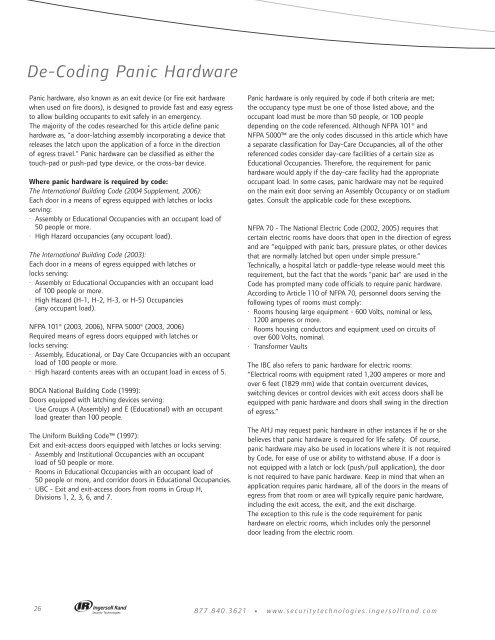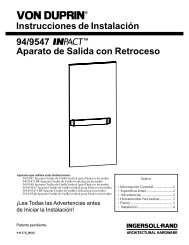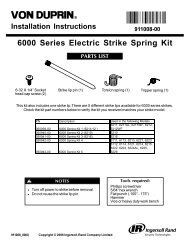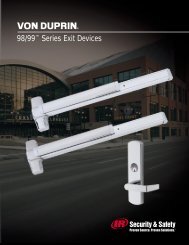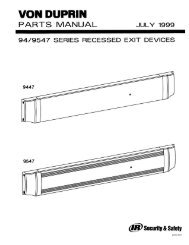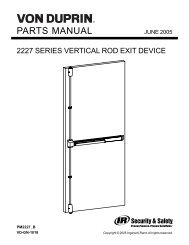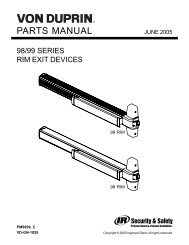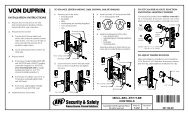Fire, Life Safety & Accessibility Codes - Von Duprin
Fire, Life Safety & Accessibility Codes - Von Duprin
Fire, Life Safety & Accessibility Codes - Von Duprin
You also want an ePaper? Increase the reach of your titles
YUMPU automatically turns print PDFs into web optimized ePapers that Google loves.
De-Coding Panic Hardware<br />
Panic hardware, also known as an exit device (or fire exit hardware<br />
when used on fire doors), is designed to provide fast and easy egress<br />
to allow building occupants to exit safely in an emergency.<br />
The majority of the codes researched for this article define panic<br />
hardware as, "a door-latching assembly incorporating a device that<br />
releases the latch upon the application of a force in the direction<br />
of egress travel." Panic hardware can be classified as either the<br />
touch-pad or push-pad type device, or the cross-bar device.<br />
Where panic hardware is required by code:<br />
The International Building Code (2004 Supplement, 2006):<br />
Each door in a means of egress equipped with latches or locks<br />
serving:<br />
· Assembly or Educational Occupancies with an occupant load of<br />
50 people or more.<br />
· High Hazard occupancies (any occupant load).<br />
The International Building Code (2003):<br />
Each door in a means of egress equipped with latches or<br />
locks serving:<br />
· Assembly or Educational Occupancies with an occupant load<br />
of 100 people or more.<br />
· High Hazard (H-1, H-2, H-3, or H-5) Occupancies<br />
(any occupant load).<br />
NFPA 101® (2003, 2006), NFPA 5000® (2003, 2006)<br />
Required means of egress doors equipped with latches or<br />
locks serving:<br />
· Assembly, Educational, or Day Care Occupancies with an occupant<br />
load of 100 people or more.<br />
· High hazard contents areas with an occupant load in excess of 5.<br />
BOCA National Building Code (1999):<br />
Doors equipped with latching devices serving:<br />
· Use Groups A (Assembly) and E (Educational) with an occupant<br />
load greater than 100 people.<br />
The Uniform Building Code (1997):<br />
Exit and exit-access doors equipped with latches or locks serving:<br />
· Assembly and Institutional Occupancies with an occupant<br />
load of 50 people or more.<br />
· Rooms in Educational Occupancies with an occupant load of<br />
50 people or more, and corridor doors in Educational Occupancies.<br />
· UBC - Exit and exit-access doors from rooms in Group H,<br />
Divisions 1, 2, 3, 6, and 7.<br />
Panic hardware is only required by code if both criteria are met;<br />
the occupancy type must be one of those listed above, and the<br />
occupant load must be more than 50 people, or 100 people<br />
depending on the code referenced. Although NFPA 101® and<br />
NFPA 5000 are the only codes discussed in this article which have<br />
a separate classification for Day-Care Occupancies, all of the other<br />
referenced codes consider day-care facilities of a certain size as<br />
Educational Occupancies. Therefore, the requirement for panic<br />
hardware would apply if the day-care facility had the appropriate<br />
occupant load. In some cases, panic hardware may not be required<br />
on the main exit door serving an Assembly Occupancy or on stadium<br />
gates. Consult the applicable code for these exceptions.<br />
NFPA 70 - The National Electric Code (2002, 2005) requires that<br />
certain electric rooms have doors that open in the direction of egress<br />
and are “equipped with panic bars, pressure plates, or other devices<br />
that are normally latched but open under simple pressure.”<br />
Technically, a hospital latch or paddle-type release would meet this<br />
requirement, but the fact that the words "panic bar" are used in the<br />
Code has prompted many code officials to require panic hardware.<br />
According to Article 110 of NFPA 70, personnel doors serving the<br />
following types of rooms must comply:<br />
· Rooms housing large equipment - 600 Volts, nominal or less,<br />
1200 amperes or more.<br />
· Rooms housing conductors and equipment used on circuits of<br />
over 600 Volts, nominal.<br />
· TransformerVaults<br />
The IBC also refers to panic hardware for electric rooms:<br />
“Electrical rooms with equipment rated 1,200 amperes or more and<br />
over 6 feet (1829 mm) wide that contain overcurrent devices,<br />
switching devices or control devices with exit access doors shall be<br />
equipped with panic hardware and doors shall swing in the direction<br />
of egress.”<br />
The AHJ may request panic hardware in other instances if he or she<br />
believes that panic hardware is required for life safety. Of course,<br />
panic hardware may also be used in locations where it is not required<br />
by Code, for ease of use or ability to withstand abuse. If a door is<br />
not equipped with a latch or lock (push/pull application), the door<br />
is not required to have panic hardware. Keep in mind that when an<br />
application requires panic hardware, all of the doors in the means of<br />
egress from that room or area will typically require panic hardware,<br />
including the exit access, the exit, and the exit discharge.<br />
The exception to this rule is the code requirement for panic<br />
hardware on electric rooms, which includes only the personnel<br />
door leading from the electric room.<br />
26 877.840.3621 • www.securitytechnologies.ingersollrand.com


